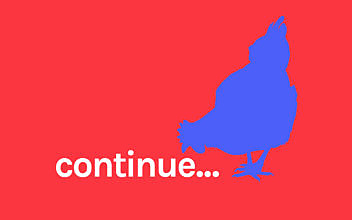Marketers often latch on to words that soften their language. Actually, humans in general do this: think of the last time you said ‘Maybe I’m wrong but …’
But these phrases, which make our declarations feel safer, also weaken them.
Think of ‘continue’: an unassuming little word that triggers the kind of resentment I usually reserve for ‘not all men’ comments and queue cutters.
And not just because ‘continue’ is the most boring word in the English language (although it drains the energy right out of a sentence).
But also because every time I see it, I think marketing has given in. Marketing should be the bearer of exciting new things: a break with the past, not a continuation of it.
A few examples of how ‘continue’ sucks the life out of copy:
In the ‘there’s absolutely no reason for this word’ category:
- B2B brands continue to struggle getting the most out of their marketing technology stack. Let me fix this for you: B2B brands struggle.
- Those that continue to innovate coming out of the pandemic will find that the “new normal” of B2B isn’t just different. I … got lost in this sentence and forgot what I was going to say.
In the ‘gutless’ league:
- Here are 40 ideas to build on for your continued business success. Oh, you polite little sentence, trying so hard not to hurt my fragile ego.
- Technology and trained managers are needed to keep everyone connected and continuing to fuel innovation and business growth, bringing supercharged creativity, productivity and employee engagement. How did ‘continuing’ sneak into an article about hyper innovation?
In the ‘you’re actively doing yourself a disservice’ division:
- Case study: how high-tech firm [redacted] has continued to innovate its business model So, you helped them do … nothing?
- Inclusion and diversity continue to be a driving force of change. You haven’t learned anything in the last few years and are just doing what you’ve always done?
How a wishy-washy word weasels its way in
Every time I see ‘continue’ in marketing copy, I picture this conversation:
Excited Stakeholder: Let’s tell buyers how our new thing will transform their world!
Marketer: Excellent! Here’s some bold copy that says just that.
Suddenly Nervous Stakeholder: But … we can’t imply anything negative. Let’s say, ‘It will continue to change their world.’
Marketer: [facepalm]
But the sadder thing is when marketers don’t even wait to have the conversation before adding the word ourselves. After years of back and forth with cautious stakeholders, we allow the weight of their opinions to suppress our best and boldest efforts.
Confidence, bragging and change
The funny thing is, continuity’s opposite—discontinuity—is what drives growth. Amazon didn’t always have two-day shipping and Salesforce didn’t start out as an app platform. Successful organizations never stop disrupting, and this goes triple for technology.
In the B2B tech world, customers aren’t just buying what you already sell, they’re buying your future. They want to know whether your product/platform/service will evolve to meet all the new stuff coming around the bend.
A confident company can say, ‘We heard you needed an easier way to do this given XYZ change, and we developed this feature to do it.’ Your stakeholders may feel exposed—this means they weren’t perfect before—but customers don’t think that way. In fact, demonstrating the ability to adapt, especially in response to customer needs, signals your products will keep getting better.
An even more confident company will say, ‘We thought we were on the right track for these excellent reasons, but now that we see it in the real world, we realize we hadn’t thought of X. So we fixed it and it’s about to get a whole lot better.’
That kind of transparency is confidence on steroids. And it’s credibility-building. When you admit hard truths (after fixing them), you project real confidence. And you send a powerful signal that people can trust your marketing. As opposed to the braggy, too-good-to-be-true marketing fluff most companies peddle to highly dubious prospects.
There’s a different scenario, too, when stakeholders are afraid of exposing their customers’ weaknesses. Your company is trying to sell a product/feature/idea that helps customers achieve something they couldn’t do before … and that necessarily means the way the customer is doing business could improve.
When you say things like ‘You can continue to get better at,’ you remove the tension that compels people to act. Skillful marketing respects their customers by demonstrating something outside their control has changed: market conditions, upstart competition, new tech that solves an old problem holding them back.
Pushing a bolder vision
Your buyers are sharp enough to pick up on the watered-down nature of ‘we continue to,’ and they don’t care about the nuance of ‘but we were always great.’ They’re also smart enough to recognize that change in B2B companies is never done. You can better advocate for boldness and clarity when you help your stakeholders get comfortable trusting buyers’ intelligence and telling them the truth without a lot of soggy qualifiers. And that, friends, is a direct route to true brand differentiation.
Continue to evangelize with confidence!

Enjoyed this article?
Take part in the discussion








Comments
There are no comments yet for this post. Why not be the first?